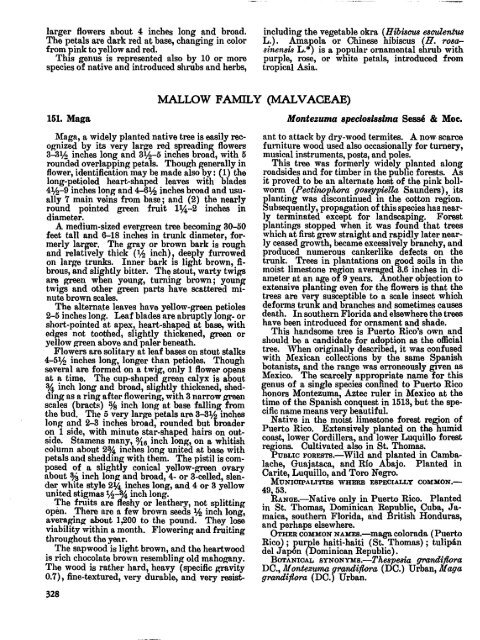Common Trees of Puerto Rico and the Virgin Islands
Common Trees of Puerto Rico and the Virgin Islands
Common Trees of Puerto Rico and the Virgin Islands
Create successful ePaper yourself
Turn your PDF publications into a flip-book with our unique Google optimized e-Paper software.
larger flowers about 4 inches long <strong>and</strong> brond.<br />
The petals are dark red at base, changing in color<br />
from pink to yellow <strong>and</strong> red.<br />
This genus is represented also by 10 or more<br />
species <strong>of</strong> native <strong>and</strong> introduced shrubs <strong>and</strong> herbs,<br />
MALLOW FAMII<br />
I*fagn, a widely planted native tree is easily recognized<br />
by its very large red spreading flowers<br />
331h inches long <strong>and</strong> 31/24 inches broad, with 5<br />
rounded overlapping petals. Though generally in<br />
flower, identification may be made also by : 1 <strong>the</strong><br />
long-petioled heart-shaped leaves with 6)ades<br />
4V2-g inches long <strong>and</strong> 66% inches broad <strong>and</strong> usually<br />
7 main veins from base; <strong>and</strong> (2) <strong>the</strong> nearly<br />
round pointed pen fruit 134-2 inches in<br />
diameter.<br />
A medium-sized evergreen tree becoming 30-50<br />
feet tall <strong>and</strong> f3-18 inches in trunk diameter, formerly<br />
larpr. The gray or brown bark is rough<br />
<strong>and</strong> relatively thick (4/2 inch), deeply furrowed<br />
on large trunks. Inner bark is light brown, fibrous,<br />
<strong>and</strong> slightly bitter. The stout, warty twig<br />
are green when young, turning brown; young<br />
twigs <strong>and</strong> o<strong>the</strong>r p n<br />
parts have scattered ml-<br />
nute brown scales.<br />
The alkrnnte leaves have yellow-peen petioles<br />
2-5 inches long. Leaf blades nre abruptly long- or<br />
short-pointed at apeq heart-shaped at base, with<br />
edges not too<strong>the</strong>d, slightly thickened, p n<br />
yellow ,men above <strong>and</strong> paler beneath.<br />
Flowers are solitary at leaf bases on stout stalks<br />
4-5s inches long, longer than petioles. Though<br />
several are formed on a twig, only 1 flower opens<br />
at a time. The cup-shaped reen calyx is about<br />
% inch long <strong>and</strong> broad, slig f tly thickened, shed-<br />
ding as a ring after flowering, with 3 narrow grean<br />
scales (bracts) Ys inch long at base falling from<br />
<strong>the</strong> bud. The 5 very large petals are 33% inches<br />
long <strong>and</strong> 2-3 inches broad, rounded but broader<br />
on 1 side, wibh minute star-shaped hairs on out-<br />
side. Stamens many, 3/le inch long, on a whitish<br />
column about 294 inches long united nt base with<br />
petals <strong>and</strong> shedding with <strong>the</strong>m. The pistil is com-<br />
posed <strong>of</strong> a slightly conical yellow-pn ovary<br />
about % inch long <strong>and</strong> broad, 4- or 3-celled, slen-<br />
der white style 2% inches long, <strong>and</strong> 4 or i) yellow<br />
united stigmas inch long.<br />
The fruits are fleshy or len<strong>the</strong>ry, not splitting<br />
open. There are a few brown seeds 1/2 inch long,<br />
averaging abut 1,200 to <strong>the</strong> pound. They lose<br />
viability within a month. Flowering <strong>and</strong> fruiting<br />
throughout <strong>the</strong> year.<br />
The sapwood is light brown, <strong>and</strong> <strong>the</strong> heartwood<br />
is rich chocolate brown resembling old mahogany.<br />
The wood is ra<strong>the</strong>r hard, heavy (specific gravity<br />
0.7), he-textured, very durable, <strong>and</strong> very resist-<br />
or<br />
including <strong>the</strong> vegetable okra (Hibiscus es&ntua<br />
L.). Amapola or Chinese hibiscus (8. rosasinen&<br />
L.''') is a popular ornamental shrub with<br />
purple, rose, or white petals, introduced from<br />
tropical Asia.<br />
Montezuma speciosissima S d<br />
& Moc.<br />
ant to attack by dry-wood termites. A now scarce<br />
furniture wood used also occasionally for turnery,<br />
musical instruments, posts, <strong>and</strong> poles.<br />
This tree was formerly widely planted along<br />
roadsides <strong>and</strong> for timber in <strong>the</strong> public forests. As<br />
it proved to be an alternate host <strong>of</strong> <strong>the</strong> pink bollworm<br />
(Pectinophora gossq&eEla Saunders) , its<br />
lanting was discontinued in <strong>the</strong> cotton region.<br />
Eubsequent1y, propagation <strong>of</strong> this species has nearly<br />
terminnted except for l<strong>and</strong>scaping. Forest<br />
plantings stopped when it was found that trees<br />
which at first grew straight <strong>and</strong> rapidly later nearly<br />
ceased growth, became excessive1 branchy, <strong>and</strong><br />
produced numerous cankerlike d efects on <strong>the</strong><br />
trunk. <strong>Trees</strong> in plantations on good soils in <strong>the</strong><br />
moist limestone re ion averaged 3.6 inches in diameter<br />
at an age o f 9 years. Ano<strong>the</strong>r objection to<br />
extensive planting even for <strong>the</strong> flowers is that <strong>the</strong><br />
trees are ve susceptible to a scale insect which<br />
deforms trun '% <strong>and</strong> branches <strong>and</strong> sometimes causes<br />
death. In sou<strong>the</strong>rn Florida <strong>and</strong> elsewhere <strong>the</strong> trees<br />
have been introduced for ornament <strong>and</strong> shade.<br />
This h<strong>and</strong>some tree is <strong>Puerto</strong> <strong>Rico</strong>'s own a?d<br />
should be a c<strong>and</strong>idate for adoption as <strong>the</strong> <strong>of</strong>ficial<br />
tree. When originally described, it was confused<br />
with Mexican collections by <strong>the</strong> same Spanish<br />
botanists, <strong>and</strong> <strong>the</strong> range was erroneously Dven as<br />
Mexico. The scarcely appro riate name for this<br />
enus <strong>of</strong> a single species con En* MI to <strong>Puerto</strong> <strong>Rico</strong><br />
Ronors Montezuma, Aztec ruler in Mexico at <strong>the</strong><br />
time <strong>of</strong> <strong>the</strong> Spanish conquest in 1513, but <strong>the</strong> specific<br />
name means very beautiful.<br />
Native in <strong>the</strong> moist limestone forest region <strong>of</strong><br />
<strong>Puerto</strong> <strong>Rico</strong>. Extensively planted on <strong>the</strong> humid<br />
coast, lower Cordillera, <strong>and</strong> lower Luquillo forest<br />
Cultivated also in St. Thomas.<br />
re$~~c m~m.-Wild <strong>and</strong> lanted in Cambalache,<br />
Guajataca, <strong>and</strong> Rio A E ajo. Planted in<br />
Carite, Luquillo, <strong>and</strong> Tom Negro.<br />
MUNIOWALITIE~ WHm EBPECIALLY COMMON.-<br />
49,53.<br />
Ra~a~.-Native only in <strong>Puerto</strong> <strong>Rico</strong>. Planted<br />
in St. Thomas, Dominican Re ublic, Cuba, Jamaica,<br />
sou<strong>the</strong>rn Florida, <strong>and</strong> B ritish Honduras,<br />
<strong>and</strong> perhaps elsewhere.<br />
OTHER COMBION NA~.-maga colorada (<strong>Puerto</strong><br />
u le haiti-haiti (St. Thomas) ; tulipfin<br />
f:BEY&t'n ~ominican Republic).<br />
BOTANIUAL s~~o~~~s.-Theap&a qmndijkra<br />
DC., Nontezztm& mndifEora (DC.) Urban, Maga<br />
gmndifbra (DC.~ urban.

















